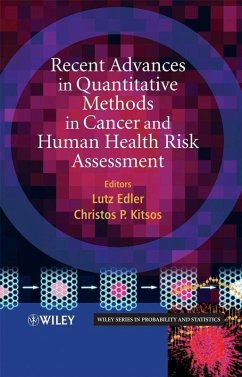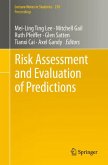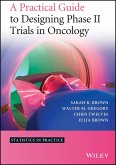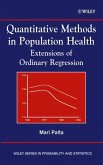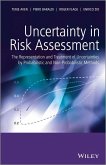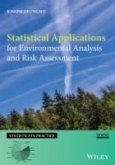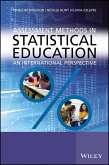Recent Advances in Quantitative Methods in Cancer and Human Health Risk Assessment (eBook, PDF)
Redaktion: Edler, Lutz; Kitsos, Christos


Alle Infos zum eBook verschenken

Recent Advances in Quantitative Methods in Cancer and Human Health Risk Assessment (eBook, PDF)
Redaktion: Edler, Lutz; Kitsos, Christos
- Format: PDF
- Merkliste
- Auf die Merkliste
- Bewerten Bewerten
- Teilen
- Produkt teilen
- Produkterinnerung
- Produkterinnerung

Hier können Sie sich einloggen

Bitte loggen Sie sich zunächst in Ihr Kundenkonto ein oder registrieren Sie sich bei bücher.de, um das eBook-Abo tolino select nutzen zu können.
Human health risk assessment involves the measuring of risk of exposure to disease, with a view to improving disease prevention. Mathematical, biological, statistical, and computational methods play a key role in exposure assessment, hazard assessment and identification, and dose-response modelling. Recent Advances in Quantitative Methods in Cancer and Human Health Risk Assessment is a comprehensive text that accounts for the wealth of new biological data as well as new biological, toxicological, and medical approaches adopted in risk assessment. It provides an authoritative compendium of…mehr
- Geräte: PC
- mit Kopierschutz
- eBook Hilfe
- Größe: 2.54MB
![Risk Assessment and Evaluation of Predictions (eBook, PDF) Risk Assessment and Evaluation of Predictions (eBook, PDF)]() Risk Assessment and Evaluation of Predictions (eBook, PDF)121,95 €
Risk Assessment and Evaluation of Predictions (eBook, PDF)121,95 €![A Practical Guide to Designing Phase II Trials in Oncology (eBook, PDF) A Practical Guide to Designing Phase II Trials in Oncology (eBook, PDF)]() Sarah R. BrownA Practical Guide to Designing Phase II Trials in Oncology (eBook, PDF)55,99 €
Sarah R. BrownA Practical Guide to Designing Phase II Trials in Oncology (eBook, PDF)55,99 €![Quantitative Methods in Population Health (eBook, PDF) Quantitative Methods in Population Health (eBook, PDF)]() Mari PaltaQuantitative Methods in Population Health (eBook, PDF)146,99 €
Mari PaltaQuantitative Methods in Population Health (eBook, PDF)146,99 €![Uncertainty in Risk Assessment (eBook, PDF) Uncertainty in Risk Assessment (eBook, PDF)]() Terje AvenUncertainty in Risk Assessment (eBook, PDF)72,99 €
Terje AvenUncertainty in Risk Assessment (eBook, PDF)72,99 €![Statistical Applications for Environmental Analysis and Risk Assessment (eBook, PDF) Statistical Applications for Environmental Analysis and Risk Assessment (eBook, PDF)]() Joseph OfungwuStatistical Applications for Environmental Analysis and Risk Assessment (eBook, PDF)100,99 €
Joseph OfungwuStatistical Applications for Environmental Analysis and Risk Assessment (eBook, PDF)100,99 €![Assessment Methods in Statistical Education (eBook, PDF) Assessment Methods in Statistical Education (eBook, PDF)]() Assessment Methods in Statistical Education (eBook, PDF)79,99 €
Assessment Methods in Statistical Education (eBook, PDF)79,99 €![Risk Assessment (eBook, PDF) Risk Assessment (eBook, PDF)]() Marvin RausandRisk Assessment (eBook, PDF)123,99 €
Marvin RausandRisk Assessment (eBook, PDF)123,99 €-
- -28%11
-
Dieser Download kann aus rechtlichen Gründen nur mit Rechnungsadresse in A, B, BG, CY, CZ, D, DK, EW, E, FIN, F, GR, HR, H, IRL, I, LT, L, LR, M, NL, PL, P, R, S, SLO, SK ausgeliefert werden.
- Produktdetails
- Verlag: John Wiley & Sons
- Seitenzahl: 502
- Erscheinungstermin: 13. Dezember 2005
- Englisch
- ISBN-13: 9780470857663
- Artikelnr.: 38184797
- Verlag: John Wiley & Sons
- Seitenzahl: 502
- Erscheinungstermin: 13. Dezember 2005
- Englisch
- ISBN-13: 9780470857663
- Artikelnr.: 38184797
- Herstellerkennzeichnung Die Herstellerinformationen sind derzeit nicht verfügbar.
ius and Mikhail S. Nikuline). 12.1 Introduction. 12.2 Models. 12.3 Parametric and semiparametric estimation. 12.4 Goodness-of-fit for the Cox model against the cross-effects models. 12.5 Examples. 12.6 Concluding remarks. Appendix: Proof of Theorem 12.1. 13. Dose-response Modeling (Lutz Edler, Annette Kopp-Schneider and Harald Heinzl). 13.1 Introduction. 13.2 Elements of the dose-response assessment. 13.3 Dose-response models. 13.4 Dose-response models in risk assessment. 13.5 Dose-Response modeling of 2,3,7,8-tetrachlorodibenzo-p-dioxin. 13.6 Concluding remarks. 14 Benchmark Dose Approach (Fred Parham and Christopher Portier). 14.1 Introduction. 14.2 Use by regulatory agencies. 14.3 Calculation methods. 14.4 Literature survey. 14.5 Software and calculation example. 15. Uncertainty Analysis: The Bayesian Approach (Frédéric Y. Bois and Cheikh T. Diack 15.1 Introduction. 15.2 Representations of uncertainty. 15.3 Causes of uncertainty. 15.4 Types of uncertainty. 15.5 Quantifying uncertainty. 15.6 Reducing uncertainty. 15.7 Conclusion. Acknowledgements. 16. Optimal Designs for Bioassays in Carcinogenesis (Christos P. Kitsos). 16.1 Introduction. 16.2 On the optimal design theory. 16.3 The Michaelis-Menten model. 16.4 Dose extrapolation designs. 16.4.1 The Weibull model. 16.5 Discussion. Acknowledgements. V SPECIFIC MODELING APPROACHES FOR HEALTH RISK ASSESSMENT. Introductory remarks 17. Cancer Risk Assessment for Mixtures (Christos P. Kitsos and Lutz Edler). 17.1 Introduction. 17.2 Basic principles. 17.3 Design of mixture experiments. 17.4 Discussion. 18. Designs and Models for Mixtures: Assessing Cumulative Risk (James J. Chen, Ralph L. Kodell and Yi-Ju Chen). 18.1 Introduction. 18.2 Experimental designs and models for whole mixture. 18.3 Dose-response modeling for component-based approach. 18.4 Component-based risk assessment for quantitative response data. 18.5 Discussion. 19 Estimating the Natural History of Breast Cancer from Bivariate Data on Age and Tumor Size at Diagnosis (Alexander V. Zorin, Lutz Edler, Leonid G. Hanin and Andrej Y. Yakovlev). 19.1 Introduction. 19.2 The model. 19.3 Estimation of model parameters. 19.4 Data analysis. Acknowledgements. VI CASE STUDIES. Introductory remarks. 20. Statistical Issues in the Search for Biomarkers of Colorectal Cancer Using Microarray Experiments (Byung-Soo Kim, Sunho Lee, Inyoung Kim, Sangcheol Kim, Sun Young Rha and Hyun Cheol Chung). 20.1 Introduction. 20.2 Experiments, data and statistical issues. 20.3 Results. 20.4 Discussion. Acknowledgements. 21. Optimal Experimental Designs for Prediction of Morbidity after Lung Resection (Jesus F. López Fidalgo, Sandra A. Garcet-Rodr&
acute;guez and Gonzálo Varela). 21.1 Medical problem. 21.2 Prediction model and advantage of designing the experiment. 21.3 Optimal experimental design approach. 21.4 Solution. 22. Logistic Regression Methods and their Implementation (Vassiliki K. Kotti and Alexandros G. Rigas). 22.1 Introduction. 22.2 Neurophysiological example. 22.3 Logistic regression. 22.4 Neurophysiological example revisited. 22.5 Discussion. 23. The use of Logistic Regression, Discriminant Analysis and Classification Trees in Predicting Persisting Remission in Childhood Leukemia (Malgorzata Ćwiklińska-Jurkowska, Piotr Jurkowski and Andrzej Koltan). 23.1 Introduction. 23.2 Patients. 23.3 Methods. 23.4 Results. 23.5 Discussion. 23.6 Concluding remarks. 24. Non-melanoma Skin and Lung Cancer Incidence in Relation to Arsenic Exposure: 20 Years of Observation (Vladim&
acute;r Bencko, Petr Franěk, Jiř&
acute; Rame, Elenóra Fabiánová and Miloslav Götzl). 24.1 Introduction. 24.2 Material and methods. 24.3 Results. 24.4 Discussion. 24.5 Conclusion. Acknowledgements. 25. Thyroid Cancer Incidence Rates in Zaragoza (Milagros Bernal). 25.1 Introduction. 25.2 Materials and methods. 25.3 Results. 25.4 Discussion. References. Index.
ius and Mikhail S. Nikuline). 12.1 Introduction. 12.2 Models. 12.3 Parametric and semiparametric estimation. 12.4 Goodness-of-fit for the Cox model against the cross-effects models. 12.5 Examples. 12.6 Concluding remarks. Appendix: Proof of Theorem 12.1. 13. Dose-response Modeling (Lutz Edler, Annette Kopp-Schneider and Harald Heinzl). 13.1 Introduction. 13.2 Elements of the dose-response assessment. 13.3 Dose-response models. 13.4 Dose-response models in risk assessment. 13.5 Dose-Response modeling of 2,3,7,8-tetrachlorodibenzo-p-dioxin. 13.6 Concluding remarks. 14 Benchmark Dose Approach (Fred Parham and Christopher Portier). 14.1 Introduction. 14.2 Use by regulatory agencies. 14.3 Calculation methods. 14.4 Literature survey. 14.5 Software and calculation example. 15. Uncertainty Analysis: The Bayesian Approach (Frédéric Y. Bois and Cheikh T. Diack 15.1 Introduction. 15.2 Representations of uncertainty. 15.3 Causes of uncertainty. 15.4 Types of uncertainty. 15.5 Quantifying uncertainty. 15.6 Reducing uncertainty. 15.7 Conclusion. Acknowledgements. 16. Optimal Designs for Bioassays in Carcinogenesis (Christos P. Kitsos). 16.1 Introduction. 16.2 On the optimal design theory. 16.3 The Michaelis-Menten model. 16.4 Dose extrapolation designs. 16.4.1 The Weibull model. 16.5 Discussion. Acknowledgements. V SPECIFIC MODELING APPROACHES FOR HEALTH RISK ASSESSMENT. Introductory remarks 17. Cancer Risk Assessment for Mixtures (Christos P. Kitsos and Lutz Edler). 17.1 Introduction. 17.2 Basic principles. 17.3 Design of mixture experiments. 17.4 Discussion. 18. Designs and Models for Mixtures: Assessing Cumulative Risk (James J. Chen, Ralph L. Kodell and Yi-Ju Chen). 18.1 Introduction. 18.2 Experimental designs and models for whole mixture. 18.3 Dose-response modeling for component-based approach. 18.4 Component-based risk assessment for quantitative response data. 18.5 Discussion. 19 Estimating the Natural History of Breast Cancer from Bivariate Data on Age and Tumor Size at Diagnosis (Alexander V. Zorin, Lutz Edler, Leonid G. Hanin and Andrej Y. Yakovlev). 19.1 Introduction. 19.2 The model. 19.3 Estimation of model parameters. 19.4 Data analysis. Acknowledgements. VI CASE STUDIES. Introductory remarks. 20. Statistical Issues in the Search for Biomarkers of Colorectal Cancer Using Microarray Experiments (Byung-Soo Kim, Sunho Lee, Inyoung Kim, Sangcheol Kim, Sun Young Rha and Hyun Cheol Chung). 20.1 Introduction. 20.2 Experiments, data and statistical issues. 20.3 Results. 20.4 Discussion. Acknowledgements. 21. Optimal Experimental Designs for Prediction of Morbidity after Lung Resection (Jesus F. López Fidalgo, Sandra A. Garcet-Rodr&
acute;guez and Gonzálo Varela). 21.1 Medical problem. 21.2 Prediction model and advantage of designing the experiment. 21.3 Optimal experimental design approach. 21.4 Solution. 22. Logistic Regression Methods and their Implementation (Vassiliki K. Kotti and Alexandros G. Rigas). 22.1 Introduction. 22.2 Neurophysiological example. 22.3 Logistic regression. 22.4 Neurophysiological example revisited. 22.5 Discussion. 23. The use of Logistic Regression, Discriminant Analysis and Classification Trees in Predicting Persisting Remission in Childhood Leukemia (Malgorzata Ćwiklińska-Jurkowska, Piotr Jurkowski and Andrzej Koltan). 23.1 Introduction. 23.2 Patients. 23.3 Methods. 23.4 Results. 23.5 Discussion. 23.6 Concluding remarks. 24. Non-melanoma Skin and Lung Cancer Incidence in Relation to Arsenic Exposure: 20 Years of Observation (Vladim&
acute;r Bencko, Petr Franěk, Jiř&
acute; Rame, Elenóra Fabiánová and Miloslav Götzl). 24.1 Introduction. 24.2 Material and methods. 24.3 Results. 24.4 Discussion. 24.5 Conclusion. Acknowledgements. 25. Thyroid Cancer Incidence Rates in Zaragoza (Milagros Bernal). 25.1 Introduction. 25.2 Materials and methods. 25.3 Results. 25.4 Discussion. References. Index.
"...a useful collection of recent works in the field."(E-STREAMS, August 2006)
"...the book can be highly recommended not only to allresearchers...but also to lecturers..." (Biometrics, Vol 61,December 2005)
